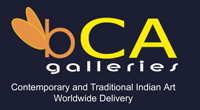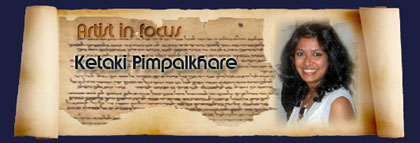Contribute
| South Asian Art - In Memory Of Prashant Fadia |
11/21/2009
Ketaki Pimpalkhare lives and works in Pune, a satellite town of the financial capital of India – Mumbai, which is also one of the prime nodes of the contemporary art movement in the country. She depicts the human spirit in a peculiar amalgamation of figurative and abstract works that serve to blur the lines between reality and some parallel universe. Having participated in numerous shows in India, she is now slowly but surely wending her way westward, where her works have transcended geographical boundaries and appealed to the sensibilities of a larger audience. Here we give you glimpses into the life of an artist who juggles her material duties as a wife, mother and business woman with the need of being a creator and expressing herself through the canvas: Being an artist in a town like Pune, what major differences do you find between that city and a big metropolitan centre for art like Mumbai I think for me, it’s been a joyride. Artists from known art centres might have an upper edge when it comes to being known, but there’s too much baggage of the style they carry around with them. As an artist, to get to a level of individuality takes forever, and if there’s a strong influence of a very well known school, it is very evident in the work. You have been for many years associated with the Christies auctions in aid of the Akanksha Foundation. How did that come about and what has been the experience like for you? You’ve recently had the opportunity to show in London and in Austria. What did you find different in the attitude and the modus operandi of galleries abroad and those in India? I thought the gallery owners were very friendly and at the same time also very professional. They were very honest with their opinions and there was nothing pretentious about their attitude. There was no pseudo factor which you tend to encounter here in India occasionally. What was the response to your art from the art lovers, artists and art critics abroad? It was very well received by all. A very positive experience for me. I felt like I was part of the art movement taking place globally. They compared my work with the modernists hailing from China and it was very heartening to know that they considered my art as a representation of the contemporary art movement in India. After preparing for my show in London, my husband and I were free for the evening. It was the first Thursday of the month, when a lot of galleries have openings. My gallery owner told us where all to go, and we had a wonderful evening hopping in and out of galleries on Vyner street in East London. I saw such honest and beautiful work, installations, paintings, sculptures and also video art. We met many local and international artists. Speaking to them was like an eye opener. Their whole approach towards their work was so different from what you usually see around here. As much as all of them were doing it to earn money, this was not the sole purpose and there was nothing commercial about their ways of display. My being one amongst such artists gave me a good insight into myself and confirmed my ideals about my work. My only advice to anybody who’s travelling is to be open. What was the experience of being able to visit two major art events in France like? I felt extremely lucky to have been in Paris at the time of the events. One was called PAVILLION DES ARTS ET DU DESIGN, at the Tuileries and the other was ART PARIS at the Grand Palais. It was like visiting 600 galleries at the same time!!! Different art from all over the world - under one roof! Also each gallery had it’s own favourite genre, be it painting, sculpture or photography. I was particularly moved by some Chinese artist’s work and a couple of German Expressionists. I could relate to it. Classical Art in Europe is far more evolved for the time than in any other part of the world. When photography was not invented, Leonardo Da Vinci painted with almost photographic precision. The ancient Greeks carved statues of the human body like they knew it inside out 3000 years ago. As compared to the arts anywhere else in the world, in India or China, the technical aspect of representation in the past was always well covered in Europe. In the contemporary art scene I was actually more impressed by the Chinese artists, there weren’t any Indian artists to speak of. That was a bit disappointing. Of all the famous galleries in India not a single one was participating in the events I attended. The contemporary art was predominantly experimental, very interesting and very progressive. You are a part of Open Canvas, an event in Pune that unites all art forms. How was this conceived and what is the response? This was conceived by a bunch of artists- painters, musicians, writers and chefs. As we considered cooking an art form as well, we decided to come together for an evening every month for the purpose of experiencing eclectic camaraderie. Where painters paint to the tunes of the musicians and food lovers try their hand at something on the hob. Everybody eventually eats whatever has been made and has fun. It’s a space where artists can mingle with art lovers and express themselves in a comfortable setting and vice versa, as I feel that more and more artists need to connect with their viewers and make them understand the purpose of their art. You seem to juggle many hats; you are an artist, a restaurant owner, wife and mother, which role takes precedence, is there ever any clash? There’s never really a clash. I feel these are all parts of my being, and I can do justice to all of them because of all the support I have from my husband, my in-laws and my parents. I don’t have to worry about my son when I’m away travelling as I know that he’s in good hands. My son is also old enough to understand. He knows it’s important for me to paint and he also paints with me. He handles my colours and huge brushes and rollers with such ease. He’s a little expressionist and I take a lot of inspiration from him. I’m collecting all of his work so that I can do a show when he’s older. He’s only 5 years old, sometimes messes around my studio, which I have to clean up. I might even get irritated with him sometimes but I’m actually happy to paint with him and watch him paint. It gives me tremendous pleasure. I believe in sharing my joys with all my loved ones and they also like to be a part of all that I do. It makes life so much more fun. That is Ketaki Pimpalkhare for you - a blithe spirit who handles all aspects of her life with ease. That she enjoys life to the fullest is seen in her artworks – they are an expression of pleasure and savouring each moment of existence. Spending time in her company or even just gazing at her artworks infuses one with a positive energy and ‘Joie de Vivre’, the world needs more people like her! ~ Razvin Namdarian
There are quite a few major differences. I think there are more opportunities in a big metro like Mumbai, in terms of art schools, their network which extends to the more well known art galleries and eventually the buyers and the collectors. There is also a lot of competition as compared to a small city, but the audience is very large and for an artist it should be important to reach out to as many people as possible and convey his/her message in their particular media in the best possible way. Also the galleries are well versed with what is happening in the international art scene, are a bit more open to experimenting, which in a small city is very rare. It’s all about exposure. But I think I’m extremely lucky to be in Pune, only 3 hours drive from Mumbai, it doesn’t keep me from being in the know of what’s happening. Also saves me a lot of stress which goes along with living in a city like Mumbai. And it’s easy to target the right buyers here as there aren’t too many.
Would you say art has been a struggle for you? According to you do artists from known art centres like Baroda, Calcutta, Delhi have it easier?
To undo that is of much concern to me, so I consider it a good thing of not having a stamp of any one of these popular schools on my work. It’s been a learning experience for me all the way.
I was once painting at this restaurant in Pune along with a few musicians in a sort of a live performance and there was an Akanksha representative there who approached me after the show to participate in the auction. I was very excited about painting with the children and Christies conducting the auction was like a bonus. I continued to be a part of all the auctions that followed. It was a beautiful experience to paint with the children, giving them all the freedom to paint whatever they wished. It was a pleasure!
Any specific incidents that come to mind in your trip abroad that you would like to share? Any advice to other artists who are preparing to exhibit abroad?
How you define the art you saw in Europe, both contemporary as well as the ones you saw in the museums?
You may also access this article through our web-site http://www.lokvani.com/

